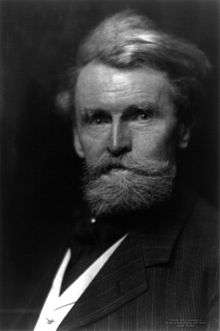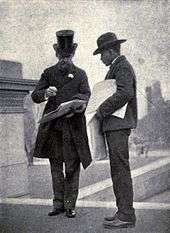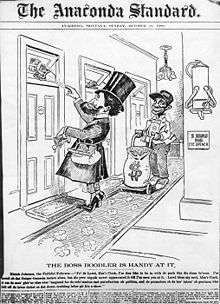William A. Clark
| William A. Clark | |
|---|---|
 | |
| United States Senator from Montana | |
|
In office March 4, 1899 – May 15, 1900 | |
| Preceded by | Lee Mantle |
| Succeeded by | Paris Gibson |
|
In office March 4, 1901 – March 4, 1907 | |
| Preceded by | Thomas H. Carter |
| Succeeded by | Joseph M. Dixon |
| Personal details | |
| Born |
William Andrews Clark January 8, 1839 Connellsville, Pennsylvania |
| Died |
March 2, 1925 (aged 86) New York City, New York |
| Resting place | Woodlawn Cemetery |
| Political party | Democratic |
| Spouse(s) | Catherine "Kate" Clark, Anna Eugenia La Chapelle Clark |
| Children |
William Andrews Clark, Jr. Andrée Clark Huguette M. Clark Charles W. Clark Katherine Clark Morris Mary J. Clark |
| Residence |
Copper King Mansion (Butte, Montana) William A. Clark House (New York City) |
| Alma mater | Iowa Wesleyan College |
| Net worth | USD $150 million at the time of his death (approximately 1/609th of US GNP)[1] |
William Andrews Clark, Sr. (January 8, 1839 – March 2, 1925) was an American politician and entrepreneur, involved with mining, banking, and railroads.[2]
Biography

Clark was born in Connellsville, Pennsylvania. He moved with his family to Iowa in 1856 where he taught school and studied law at Iowa Wesleyan College. In 1862, he traveled west to become a miner.[3] After working in quartz mines in Colorado, during 1863 Clark made his way to new gold fields to find his fortune in the Montana gold rush.
He settled in the capital of Montana Territory, Bannack, Montana, and began placer mining. Though his claim paid only moderately, Clark invested his earnings in becoming a trader, driving mules back and forth between Salt Lake City and the boomtowns of Montana to transport eggs and other basic supplies.
He soon changed careers again and became a banker in Deer Lodge, Montana. He repossessed mining properties when owners defaulted on their loans, placing him in the mining industry. He made a fortune with copper mining, small smelters, electric power companies, newspapers, railroads (trolley lines around Butte and the Los Angeles and Salt Lake Railroad (SP,LA&SL RR) from Salt Lake City, Utah to San Pedro and Los Angeles, California), and other businesses, becoming known as one of three "Copper Kings" of Butte, Montana, along with Marcus Daly and F. Augustus Heinze.
Between 1884 and 1888, Clark constructed a 34-room, Tiffany-decorated home on West Granite Street, incorporating the most modern inventions available, in Butte, Montana. This home is now the Copper King Mansion bed-and-breakfast and museum.[4] In 1899 Clark built the Columbia Gardens for the children of Butte. It included flower gardens, a dance pavilion, amusement park, lake, and picnic areas.
He died March 2, 1925 and is interred in Woodlawn Cemetery in The Bronx, New York City.
Political career
Clark served as president of both Montana state constitutional conventions in 1884 and 1889.

Clark yearned to be a statesman and used his newspaper, the Butte Miner, to push his political ambitions. At this time, Butte was one of the largest cities in the West. He became a hero in Helena, Montana, by campaigning for its selection as the state capital instead of Anaconda. This battle for the placement of the capital had subtle Irish vs. English, Catholic vs. Protestant, and Masonic vs. non-Masonic elements. Clark's long-standing dream of becoming a United States Senator resulted in scandal in 1899 when it was revealed that he bribed members of the Montana State Legislature in return for their votes. At the time, U.S. Senators were chosen by their respective state legislators. The corruption of his election contributed to the passage of the 17th Amendment. The U.S. Senate refused to seat Clark because of the 1899 bribery scheme, but a later senate campaign was successful, and he served a single term from 1901 until 1907. In responding to criticism of his bribery of the Montana legislature, Clark is reported to have said, "I never bought a man who wasn't for sale."[5]
Clark died at the age of 86 in his mansion at 962 Fifth Avenue in New York City, one of the 50 richest Americans ever.[6]
In a 1907 essay Mark Twain portrayed Clark as the very embodiment of Gilded Age excess and corruption:
He is as rotten a human being as can be found anywhere under the flag; he is a shame to the American nation, and no one has helped to send him to the Senate who did not know that his proper place was the penitentiary, with a ball and chain on his legs. To my mind he is the most disgusting creature that the republic has produced since Tweed's time.[7]
Mark Twain's comments must be taken in context. He was a close friend of Henry H Rogers, one of the organizers of the Amalgamated Copper Company to gain control of Butte's mines in opposition to Clark. Twain is not an unbiased observer.[8]
Family

Clark was married twice. His first wife was Katherine Louise "Kate" Stauffer (1844 Pennsylvania – 1893 New York). Together, they had seven children:
- Mary Joaquina Clark (1870 – 1939) (m. Everett Mallory Culver, Charles Potter Kling, and Marius de Brabant)
- Charles Walker Clark (1871 – 1933) (m. Katharine Quin Roberts and Cecelia "Celia" Tobin)
- Unnamed son (1874–1874)[9]
- Jessie Clark (1875–1878)[9]
- Katherine Louise Clark (1875 – c. 1933) (m. Dr. Lewis Rutherford Morris 1862-1936)[10]
- William Andrews Clark, Jr. (1877 – 1934) (m. Mabel Foster and Alice McManus)
- Paul Francis Clark (1880 – 1896)
After Kate's death in 1893, William married his second and final wife, the woman who had been his teenage ward, Anna Eugenia La Chapelle (March 10, 1878 Michigan – October 11, 1963 New York). They claimed to have been married in 1901 in France. Anna was 23 and William was 62.[11] They had two children:
- Louise Amelia Andrée Clark (August 13, 1902 San Lucas, Spain – August 6, 1919 Rangeley, Maine)
- Huguette Marcelle Clark (June 9, 1906 Paris, France – May 24, 2011, New York City).[12]
William Clark donated 135 acres to the Girl Scouts in honor of his daughter, Louise Amelia Andrée, who died aged 16 of meningitis and had been very happy there. The Girl Scout camp in Briarcliff Manor was named Camp Andree Clark.[13]
William Andrews Clark, Jr.
Clark's son, William Andrews Clark, Jr., founder of the Los Angeles Philharmonic in 1919, left his library of rare books and manuscripts to the regents of the University of California, Los Angeles. Today, the William Andrews Clark Memorial Library specializes in English literature and history from 1641 to 1800, materials related to Oscar Wilde and his associates, and fine printing.
Huguette Marcelle Clark
Huguette (pronounced: oo-GETT), born in Paris, France in June 1906, was known as a reclusive heiress and was the youngest child of Clark with his second wife, Anna Eugenia La Chapelle. She married once, but divorced less than a year later. She led a reclusive life thereafter, communicating very little with the public including her extended family. She lived in three magnificent apartments, with a total of 42 rooms, on New York's Fifth Avenue at 72nd Street, overlooking Central Park. In 1991, she moved out of her apartment in New York and for the remainder of her life, voluntarily lived in various New York City hospitals.
In February 2010, she became the subject of a series of reports on msnbc.com after it was reported that the caretakers of her three residences (including a $24 million estate in Connecticut, a sprawling seaside estate in Santa Barbara, California and her Fifth Avenue apartments valued at $100 million) had not seen her in decades. These articles were the basis for the 2013 bestselling book Empty Mansions: The Mysterious Life of Huguette Clark and the Spending of a Great American Fortune by investigative reporter Bill Dedman.
Her final residence was Beth Israel Medical Center, where she died on the morning of May 24, 2011, age 104.[14] Huguette's extraordinary collection of arts and antiquities were consigned to go on the auction block at Christie's in June 2014, over three years after her death.[15]
Clarkdale, Arizona
Clarkdale, Arizona, named for Clark, was the site of smelting operations for Clark's mines in nearby Jerome, Arizona. The town includes the historic Clark Mansion, which sustained severe fire damage on June 25, 2010. Clarkdale is home to the Verde Canyon Railroad wilderness train ride which follows the historic route that Clark had constructed in 1911 and home to the Copper Art Museum.[16]
Legacy
Clark's art collection was donated to the Corcoran Gallery in Washington, D.C. after his death, greatly enriching that museum's holdings of European as well as American art. The Clark donation also included the construction of a new wing for the Corcoran, known appropriately as the Clark Wing.
The city of Las Vegas was established as a maintenance stop for Clark's San Pedro, Los Angeles and Salt Lake Railroad. He subdivided 110 acres into 1200 lots, some of which on the corner of Fremont Street in Las Vegas sold for as much as $1750. The Las Vegas area was organized as Clark County, Nevada, in Clark's honor.
See also
- Atlantic Cable Quartz Lode
- Mary Andrews Clark Memorial Home – landmark Los Angeles home for women built by Clark as memorial for his mother
Notes
- ↑ Klepper, Michael; Gunther, Michael (1996), The Wealthy 100: From Benjamin Franklin to Bill Gates—A Ranking of the Richest Americans, Past and Present, Secaucus, New Jersey: Carol Publishing Group, p. xiii, ISBN 978-0-8065-1800-8, OCLC 33818143
- ↑ "Copper King William A. Clark". Copper King Mansion. Retrieved July 31, 2011.
- ↑ Dedman, Bill (2013). Empty Mansions (Paperback ed.). New York: Ballantine Books. p. 22. ISBN 978-0-345-53453-8.
- ↑ Tribune Staff. "125 Montana Newsmakers: The Copper Kings". Great Falls Tribune. Retrieved August 28, 2011.
- ↑ The Washington Post, May 25, 2011, "Metro: Obituary" page B7, "Huguette Clark, 104: Copper heiress lived in opulent isolation".
- ↑ Pitts, Stanley Thomas (May 2006). An Unjust Legacy: A Critical Study of the Political Campaigns of Wiliam Andrews Clark, 1888-1901 (PDF). University of North Texas: M.S. thesis. p. 205. Retrieved October 22, 2016.
- ↑ "Senator Clark of Montana." In Mark Twain in Eruption, ed Bernard DeVoto, 1940.
- ↑ Dias, Elias (1984). Mark Twain and Henry Hittleston Rogers: An Odd Couple. Fairhaven, Massachusetts: Millicent Library. LCCN 84062878.
- 1 2 The Family of W.A. Clark (PDF)
- ↑ "Glendale Pioneers". Retrieved June 22, 2014.
- ↑ "At 104, mysterious heiress is alone now - Business - Local business - Huguette Clark mystery - NBC News". msnbc.com.
- ↑ Dedman, Bill (May 24, 2011), Huguette Clark, the reclusive copper heiress, dies at 104, msnbc.com, retrieved May 24, 2011
- ↑ "Camp Andree Clark".
- ↑ Fanelli, James (September 7, 2010), Huguette Clark's lawyer fires back at relatives who want him ousted, NYDailyNews.com, retrieved September 8, 2010
- ↑ "Eccentric Heiress's Untouched Treasures Head For The Auction Block", National Public Radio, Margot Adler, June 17, 2014. Retrieved June 22, 2014.
- ↑ Peterson, Hellen Palmer (May 2008). Landscapes of Capital: Culture in an Industrial Western Company Town, Clarkdale, Arizona, 1914-1929. Northern Arizona University: Ph.D. dissertation. p. 214. Retrieved October 22, 2016.
Sources
- Dedman, Bill; Clark Newell, Paul, Jr. (2013), Empty Mansions: The Mysterious Life of Huguette Clark and the Spending of a Great American Fortune, New York: Ballantine Books, ISBN 978-0-345-53452-1
- NBCNews.com: Huguette Clark, the reclusive heiress, and the men managing her money, an NBCNews.com special report
- United States Congress. "William A. Clark (id: C000454)". Biographical Directory of the United States Congress.
- Hopkins, A.D.; Evans, K.J. (2000), The First 100, Las Vegas: Huntington Press, ISBN 0-929712-67-6
- Mangam, William (1941), The Clarks An American Phenomenon, New York, NY: Silver Bow Press, OCLC 390214
External links
| Wikimedia Commons has media related to William A. Clark. |
- NBCNews.com: Huguette Clark, the reclusive heiress, and the men managing her money, an NBCNews.com special report
- Empty Mansions: The Mysterious Life of Huguette Clark and the Spending of a Great American Fortune
- Biographical Sketch
- William A. Clark at Find a Grave
| United States Senate | ||
|---|---|---|
| Preceded by Lee Mantle |
U.S. Senator (Class 1) from Montana 1899–1900 Served alongside: Thomas H. Carter |
Succeeded by Paris Gibson |
| Preceded by Thomas H. Carter |
U.S. Senator (Class 2) from Montana 1901–1907 Served alongside: Paris Gibson, Thomas H. Carter |
Succeeded by Joseph M. Dixon |

